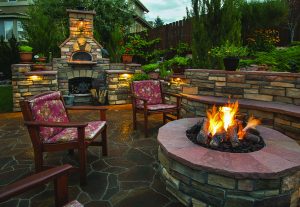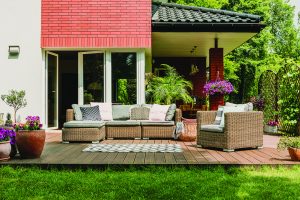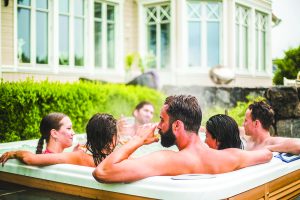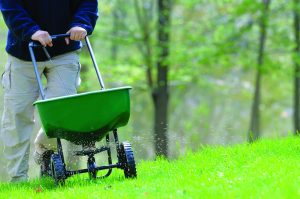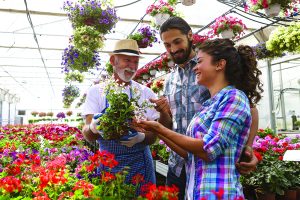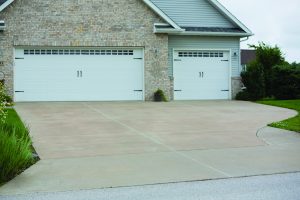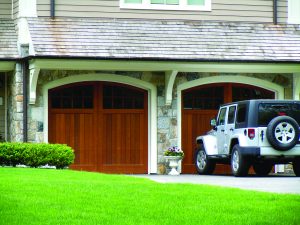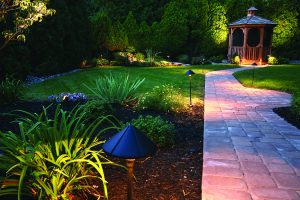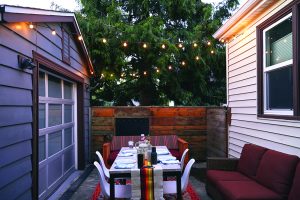SPRING HOME GUIDE
Must Have Items For Summer Entertaining In The Backyard
Summer entertaining season provides ample opportunities to soak up some sun and have some fun with family and friends. Backyard barbecues and other get-togethers at home are even more fun when hosts ensure they have certain must-have items for summer soirees.
The days when summer hosts only needed a few extra lawn chairs and some burgers and hot dogs on the grill for a backyard barbecue are long gone. Though those items still have a place at backyard barbecues, summer parties have taken a step up. Fire features, whether it’s a standalone fire pit, one built into a patio or a gas-powered fire table, are now wildly popular. Fire features provide a welcome place to relax and converse with guests after the sun goes down. And much to kids’ delight, a fire feature also paves the way for some post-meal s’mores.
Coolers are great places to store water, soda, beer, seltzers, and other popular beverages. But what about wine? An insulated wine cooler ensures wine stays properly cooled but doesn’t get too cold, which can happen when wine is stored in a more traditional cooler filled with ice. Bottles are simply placed in the insulated cooler (much like canned beverages slide easily into can koozies), and the bottle can be kept on the table much like you would for formal dinners indoors. Hosts can go the extra mile by pairing insulated wine tumblers with their wine cooler.
Summer entertaining season might be all about relaxation, but games can up the fun factor at backyard gatherings. Cornhole is a wildly popular game, and customized cornhole boards can help hosts come across as party professionals. Ladder toss, bocce and wiffle ball are some additional games that can make the festivities more fun. Hosts who don’t have a pool also can invest in an inflatable pool big enough to fit all the kids who will be coming to the party.
Hosts can save themselves the stress and effort of walking in and out for dinnerware and other table accessories by investing in a sturdy outdoor storage cabinet. As meal time draws near, hosts will appreciate that all the plates, napkins, utensils, and placemats are already outside. The top of the storage cabinet can double as a small but convenient buffet station for sides that aren’t being cooked over an open flame.
A projector and screen can really up the ante on summer entertaining, turning a backyard barbecue into a great place to watch a game or cuddle up after dinner for a movie night under the stars. Projectors and screens won’t bust the budget, but those who have more to spend may want to consider an outdoor television. Outdoor televisions are built to handle the glare of the summer sun, but a retractable awning may be a good safety net for hosts who plan to spend many a weekend afternoon outside watching games or movies with family and friends.
These are just a handful of items that can up the ante on traditional backyard barbecues. Homeowners should know that there’s no limit to the number of items that can make summer entertaining season more special.
What To Know About Installing A Pool At Home
Summer is a season of relaxation when school is not in session, vacation season is in full swing and people everywhere are getting outside and soaking up the summer sun. It’s hard to imagine how that can get any better. But it can for people thinking of installing a pool in their backyard.
Pools definitely have a wow factor that’s hard to replicate. Homeowners considering pool installation can take note of these factors as they try to decide if a pool is right for them.
The cost to install a pool depends on a host of factors, including which type of pool homeowners are considering and where they live. According to the online home improvement resource Angi (formerly Angie’s list), the average cost to install an above ground pool in the United States in 2022 was $3,322, while the average inground pool installation in the same year was $55,000. That’s quite a disparity in price, and homeowners should know that the average cost of each project is higher in certain regions and under certain circumstances. Potential ancillary costs, such as excavation and plumbing relocation, will add to the final cost of the project. The erection of fencing around the pool if no fencing currently surrounds the area where the pool will be located also will add to the final cost.
As noted, above ground pools, on average, require a considerably smaller financial investment than inground pools. This is an important consideration, but which option may ultimately prove the better investment is worth researching. Homeowners can speak with a local real estate professional to determine if an inground pool or above ground might yield a significantly higher return at resale. If an inground pool is likely to increase property value by a substantial amount, it could be well worth the extra upfront costs.
Pools are undeniably fun, but they still require maintenance. The experts at Better Homes & Gardens note that vinyl liners in pools last approximately six to 10 years, while painted concrete may require a fresh coat of paint every five years. Plaster finishes may last as long as 15 years, while cement-coated products can last a lifetime. Pools also need periodic cleaning, and chemicals to keep the pool operating safely and cleanly will require an additional, if somewhat minimal, financial investment. Homeowners investing in a new pool should be aware of the maintenance required to keep the pool clean and be willing to do that maintenance. And though homeowners typically can open and close pools on their own, it’s also possible to hire someone to do it for a relatively small fee each season.
A survey of the land in a yard can reveal how smoothly a pool installation may or may not go. Though it’s possible to install a pool in just about any yard, some spaces might require greater preparation and pre-installation effort than others. Sloped backyards, for example, may require the services of a landscape architect to prepare the space, which can extend the time it takes to complete the project and add the overall cost.
These are just some of the factors that merit consideration when mulling a pool installation. A homeowners’ best resource might be a local pool company who can visit a home, provide an estimate and point out any challenges that may arise during the install.
DID YOU KNOW?
A recent survey of home renovation industry professionals conducted by Fixr.com found that creating indoor spaces outdoors was homeowners’ biggest priority regarding renovations in 2022. Sixty-two percent of renovation-minded homeowners surveyed indicated outdoor dining areas are their most sought-after living space. In addition, 41 percent of respondents felt outdoor kitchens were their biggest priority. The survey found that certain outdoor living space features were especially popular, none more so than comfortable outdoor furniture. Firepits, outdoor fireplaces, swimming pools, hot tubs, and outdoor connectivity were some additional popular features among homeowners focused on their outdoor living spaces.
How To Make Outdoor Living Spaces More Comfortable
Private backyards are now go-to spaces for recreation and entertainment and great places to recharge the body and mind.
One ripple effect of the COVID-19 pandemic was more time spent outdoors, even if it was predominantly on one’s own property. OnePoll, in conjunction with the lawn care company TruGreen, surveyed 2,000 American homeowners and found participants spent 14 hours outside every week in 2021, which was three hours more than prior to the pandemic. In addition, respondents admitted that time spent outdoors was therapeutic.
A separate survey conducted for the International Casual Furnishings Association found that people now spend more time relaxing, gardening, exercising, dining, and entertaining outside than in years past. Though COVID-19 may no longer dominate headlines, the desire to enjoy outdoor spaces has not waned.
While enjoying outdoor living areas, homeowners can do all they can to make these spaces comfortable and welcoming. The following are some good starting points.
Outdoor spaces can be enjoyed no matter the hour when there is ample lighting. That could be why the International Casual Furnishings Association reports those who plan to renovate their outdoor spaces list outdoor lighting as a priority. Outdoor lighting not only sheds light on entertaining spaces, but also makes spaces safer and more secure.
No matter how friendly homeowners are with their neighbors, there comes a time when privacy is paramount. Fencing, whether it is wood or vinyl, or even a natural fence made from closely planted hedges, can ensure residents feel comfortable venturing outdoors to swim, take a cat nap or even star gaze in private.
Homeowners should note the direction their backyard faces and the typical daily conditions of the space. For example, a yard that faces southwest may get plenty of strong sun during the day, requiring the addition of shade trees, covered patios or arbors to cut down on the glare and heat. If the yard is often hit by winds, trees or bushes planted strategically as windbreaks can help.
High-quality comfortable seating increases the likelihood that homeowners will want to stay awhile in their outdoor spaces. A deep seating set complete with plush chairs, outdoor sofa or love seat and chaise lounge chairs gives people more opportunity to sit and stay awhile.
A pool can be the perfect gathering spot on a warm day, while a spa/hot tub can bridge the gap to cooler weather. According to the Family Handyman, soaking in hot tubs can relax tired muscles after a long day, loosen up stiff joints, improve cardiovascular health, and reduce the time it takes to fall asleep.
Homeowners may want to consider using a professional exterminator to get rid of ticks, mosquitoes and other nuisance insects from outdoor spaces.
As people spend more time enjoying their properties, they can consider the many ways to make outdoor living spaces more comfortable.
Turn A Backyard Into Your Own Relaxing Respite
Backyards have long been places to unwind and enjoy some peace and quiet surrounded by nature.
Thanks in part to financial instability brought on by rising inflation and measures to tame it, homeowners may decide to forgo traditional vacations in favor of staying home this season. There’s no better time to invest in a home, particularly outdoor spaces, to make them welcoming respites. The following are some ways to accomplish that goal.
The sound of trickling or bubbling water can make surroundings more serene. A low-maintenance water feature can help to create a calming ambiance. A fountain that does not require a collection pond will reduce the chance it becomes a breeding ground for mosquitoes. Locating the fountain out of the sun can keep algae growth at a minimum.
Outdoor lighting options include professionally installed, hardwired lights on the home itself or accent lighting that draws attention to trees or architectural structures on the property. It also may include twinkling lights, which some consider a must-have for any outdoor retreat. Lights come in all types and price points. Hang them on porches, pergolas or cement posts inside decorative planters and then string lights between the posts. This way the lighting can be moved around as desired.
A comfortable outdoor loveseat or chairs may be a focal point of the yard, but build in some additional cozy spots specifically for lounging around. Nestle a hammock in a quiet corner of the yard, or enhance a chaise lounge with throw pillows and a large umbrella for napping poolside.
Plants can transform any space. Use a combination of planted varieties around the yard, then enhance certain areas with potted plants as needed. Plants can make an area more warm and inviting, plus they give butterflies, bees and hummingbirds places to stop by and visit. Consider the help of a professional landscaper to bring a vision of a lush, plant-filled retreat to life.
With some unique landscape architecture, the pool or hot tub can be built right into the landscape, making it a cohesive part of the design. This can make the yard seem even more like an oasis, especially when the pool is flanked by a waterfall or bubbling fountain.
Thanks to wireless speakers that rely on Bluetooth technology, it’s easy to have music piped right into the backyard. Set up a wireless speaker in an inconspicuous spot, such as inside a planter or in the rafters of a gazebo.
Turning a backyard into an oasis can provide the respite many people look for on their properties.
Create Your Native Plant Garden
Gardening is a worthwhile endeavor that not only passes the time, but can be a form of exercise and relief from the daily grind. Gardens also provide ample opportunity to experiment, as individuals can produce everything from vegetables to bountiful blooms.
Recent years have witnessed a growing emphasis on eco-friendly gardening that aims to reduce reliance on chemical fertilizers and pesticides in an effort to protect the planet. One way to do so is to rely on native plants.
Native plants are indigenous to particular regions. The National Wildlife Federation says native plants grow in habitats without human introduction or intervention. Native plants have formed symbiotic relationships with local wildlife over thousands of years, which the NWF notes makes them the most sustainable options. Native plants help the environment and thrive with little supplemental watering or chemical nutrients.
Native plants vary by region. In arid climates, certain succulents may be native because they don’t need much rainfall to thrive. In lush wetlands, succulents might be out of place.
The NWF offers native plants for 36 different states that can be shipped right to customers’ doors to help replenish native varieties. In addition, gardeners can visit local gardening centers to select native plants. Small and independently owned centers often feature knowledgeable local staff whose expertise can prove invaluable to individuals seeking native varieties.
It’s important to keep in mind that native varieties may look less cultivated than more exotic blooms and foliage designed to sell for their unique appearances. Wildflowers and native grasses may be the types of native plants found in abundance, which may grow up and out quickly. These other tips can help the process.
• Plan and prepare the site by removing weeds and turning over the soil. This will give seedlings an opportunity to take root without competition from weeds. Seedlings will give gardens a faster head-start than waiting around for seeds to germinate. However, gardeners can start seeds indoors and then move them outside once they are seedlings.
• Avoid planting native plants in rows, as that’s not how they’re likely to grow naturally. Vary the placement so the plants look like they sprouted up haphazardly.
• Gardeners can still exert some control over native gardens prone to growing a little wild. Borders and paths can better define the growing areas.
• Grow Native!, an initiative from the Missouri Prairie Foundation, suggests planting two to four species in broad sweeping masses or drifts. Mix grasses with flowering plants. The grasses produce dense, fibrous roots that can prevent weed growth.
Native plants should require minimal care. Keep an eye on them and supplement with water if conditions have been especially dry.
The Benefits of Energy-Efficient Homes
Consumer efforts to be more eco-conscious are more and more noticeable. For proof of that, one need look no further than the increase in vehicle charging stations. Such stations are more accessible than ever and illustrate that consumer preference is increasingly leaning toward products that leave as small a carbon footprint as possible.
Another indicator of a growing interest in eco-friendly products is the popularity in energy-efficient homes. In fact, a recent survey from the National Association of Home Builders found that energy-efficient features are among the most sought-after “must-haves” among homebuyers. Among those surveyed, 83 percent desired Energy Star-rated windows, 81 percent wanted Energy Star-rated appliances and 80 percent preferred energy-efficient lighting.
Though eco-conscious sensibilities compel millions of homeowners to make their homes more energy-efficient, that’s not the only reason to upgrade your home. The following are a handful of the many benefits of energy-efficient homes.
• Save money: Inflation was one of the biggest stories of 2022, as the cost of living rose dramatically in the wake of world events. According to data from the U.S. Bureau of Labor Statistics, inflation led to an overall 6.5 percent increase in prices. But that increase was dwarfed by the cost of electricity, which increased by 14.3 percent in 2022. Energy-efficient appliances can help homeowners overcome that spike, as the U.S. Department of Energy indicates upgrading to such products can help homeowners reduce their energy costs by as much as 30 percent.
• Improve resale value: As the NAHB survey indicates, modern homebuyers want energy-efficient homes. They’re also willing to pay more for such homes. Research from the mortgage lender Freddie Mac found that homes with energy-efficient ratings sold for nearly 3 percent more on average than homes without such ratings.
• Live healthier: The benefits of energy-efficient homes aren’t just economic, though health-related benefits certainly produce an economic incentive as well. According to the American Council for an Energy-Efficient Economy, insulation and air sealing protect individuals from heat waves and other ripple effects of climate change. The ACEEE notes that weatherization can improve indoor air quality and comfort, a notable benefit for asthma sufferers and seniors. In fact, the ACEEE estimates that integrating energy efficiency programs in homes could reduce seniors’ risk for falls in their homes, potentially saving $2 billion in fall-related health care costs over the next decade, and improve asthma outcomes, which could reduce health care costs by as much as half a billion dollars.
Energy-efficient products and practices pay numerous dividends, making them a worthy expenditure for any homeowners looking to upgrade their homes.
How To Make A Backyard Safe For Dogs
Dogs, particularly puppies, can be full of boundless energy. Channeling that energy into exercise with long walks or play sessions can help stem dogs’ propensity to get into trouble around the house as they burn off extra adrenaline. Pets who don’t have an energy outlet may chew off-limits objects or get into other mischief.
According to the American Kennel Club, the amount of exercise a dog needs depends on the animal’s age and breed. For example, border collies or Siberian huskies may require much more exercise than English bulldogs, simply because the former are working breeds. Pet owners with large backyards often find those outdoor spots are ideal for when their dogs get the “zoomies,” something that tends to be a daily occurrence. Letting their dogs run around yards, whether on their own or chasing tossed tennis balls, is an ideal way to provide exercise and tire out pups. In such scenarios, it’s vital that pups have a dog-friendly yard in which to play.
An expanse of grass is the perfect place to frolic or enjoy some sunbathing – for people or pets. But contact with chemically treated lawns can cause a number of health issues for dogs, such as allergies or intestinal upset.
Switching to native grasses can reduce the need to use chemicals to get lush lawns. When supplementation is needed, homeowners can switch to organic products or natural compost as safer alternatives than chemical-based products.
Off-leash running and bounding through the yard will make any dog smile. However, a fence is a must-have to ensure a dog doesn’t become an escape artist. Be sure the fence is high enough so that the pup cannot jump over it. Burying chicken wire in the dirt beneath the lower edge of the fence also can help prevent dogs who like to dig from exiting by crawling underneath the fence.
Consider installing a lock on the fence gate so that no one can wander in and surprise the dog, which may startle the animal and prompt it to defend the property. A lock also helps prevent dog theft.
Maintaining a clean yard also is key to safety. Inspect the yard regularly to make sure nothing is around that can prove harmful, whether it’s poison ivy, felled branches or broken fence panels. Also, keep shrubs and grass trimmed to reduce flea and tick populations on the property.
Certain plants can be dangerous if they’re consumed by curious pups. Chrysanthemums, peonies, irises, and hydrangeas are some plants that can be poisonous. For a full list of poisonous plants, visit the ASPCA website (aspca.org).
Dogs can spend some unattended time in the yard, but check in from time to time. Should wildlife get into the yard, dogs may get hurt by tussles or bites. Birds of prey, such as owls, hawks and even vultures, may attack small dogs in a yard. According to Pat Silvosky, director of the Milford Nature Center in Kansas, some birds can be territorial. While they might not view a dog as an easy meal, they could swoop down and attack to defend territory. The same may occur with other wild animals.
A dog-friendly yard may require a little effort to create, but it’s worth a little sweat equity to keep pups safe.
The Basics of Fertilizing a Lawn
Spring marks the return of lawn and garden season. Lawns often bear the brunt of winter’s wrath, so spring is a great time to nurse them back to health, and fertilizing can be an essential component of that process.
Fertilizing a lawn can be intimidating. An array of fertilizers, with each seemingly designed to address a different issue, can make homeowners’ heads spin when visiting their local lawn and garden center. However, fertilizing is a very simple task that any homeowner can tackle. In fact, fears about fertilizing are often unfounded and can be overcome with some basic knowledge of the process.
· Identify which type of grass is in the yard. The home improvement experts at HGTV note that turfgrass is divided into two categories: cool-season grass and warm-season grass. A local lawn and garden center can help homeowners identify which type of grass is in the yard, and this often depends on location. Fescue, bluegrass and perennial ryegrass are some examples of cool-season grasses, while Bermuda, bahia, St. Augustine, and zoysia are considered warm-season grasses. Identifying which type of grass is in the lawn is important because that will indicate when to fertilize. Cool-season grasses are typically best fertilized in early spring, while warm-season lawns can benefit from an application just before especially warm temperatures arrive.
· Survey the lawn to identify which spreader to use. A small yard or a thriving lawn with only a few bald or unsightly patches may not need a full application of fertilizer. In such instances, a hand spreader can suffice. For larger lawns and areas, a broadcast spreader is the ideal option. Spreaders have multiple settings, and the fertilizer package will indicate which setting to utilize when using the product.
· Test the soil prior to purchasing fertilizer. The lawn experts at Pennington® note that a simple soil test can reveal soil pH and phosphorous and potassium levels. Soil tests can be purchased at most home improvement stores and lawn and garden centers, and they can help homeowners determine which fertilizer will most benefit their lawns.
· Water the lawn prior to fertilizing. The experts at Scotts® recommend a good watering a few days prior to fertilizing a lawn. Such an approach ensures the soil is ready to accept the fertilizer once it’s applied.
· Follow the instructions carefully. Detailed instructions are typically provided on fertilizer product packaging. Once homeowners have identified and purchased the product they need, they can simply follow the instructions on the packaging, including how and when to water after application, which can make fertilizing less intimidating.
Fertilizing in spring can help a lawn recover from the previous summer and winter, ensuring it’s lush and green when summer entertaining season arrives.
The Benefits of Planting Native Species
Spring and summer present ideal growing conditions for many plants, making these seasons an ideal time to tend to lawns and gardens. Though it’s easy to succumb to the temptation of exotic plants, avid gardeners and eco-conscious planters recognize the significance of native plants.
Novices may not realize that native plants are much better for a landscape and the local ecosystem it calls home. Recognition of the many benefits of native plants can make for healthier lawns and gardens and a healthier planet as well.
· Native plants are built for local climates. One of the issues gardeners who plant exotic plants run into is keeping those plants thriving when weather turns harsh. For example, exotic plants may require extra watering in areas that experience drought or even long periods without precipitation in spring and notably summer. The United States Environmental Protection Agency reports that at least 40 states anticipate water shortages by 2024. Planting native plants can help to combat those shortages by reducing the need to water plants if conditions become dry in late spring and summer.
· Native plants save money. It’s also important to note that native plants save homeowners money. Because they’re capable of thriving in local conditions, native plants tend to require less watering, which can hep homeowners reduce their utility costs. But native plants also require less upkeep, which means homeowners can save on potentially costly, not to mention eco-unfriendly, pesticides and other amendments in order to maintain the look of exotic plants. And though it’s not always the case, exotic plants tend to cost more at nurseries than natives.
· Native plants save gardeners time. In addition to saving money, native plants don’t require as much attention. Though spring and summer is a great time to be in the yard, it’s also a great time to be out and about. Because native plants thrive in local conditions, gardeners won’t need to spend much of their free time tending to them. Exotics tend to require a lot of extra attention and effort, especially when conditions become harsh. Spending more time outdoors in harsh weather does not appeal to most gardeners.
· Native plants blend in with an existing landscape. Native plants look natural within an existing landscape, adding some instant aesthetic appeal without breaking the bank. When planting exotics, homeowners may feel a need to redesign their entire gardens to create a certain look (think Japanese garden). That can quickly consume a budget and take up a lot of free time in both the short- and long-term.
Planting season marks a great time to revitalize a landscape. Choosing native plants when doing so pays numerous dividends for homeowners and the planet they call home.
Signs A Home Exterior Needs Updating
Renovations are a great way for homeowners to reshape their homes. Some may aspire to renovate so their home is more reflective of their personal taste, while others may do so in an effort to make their homes better align with modern styles and sensibilities. Regardless of why a homeowner chooses to renovate, the need to do so is often evident to the naked eye, especially when the time comes to update home exteriors.
Curb appeal is often discussed in regard to the effects it can have when selling a home. But curb appeal is equally important for homeowners who aren’t putting their homes on the market. A well-maintained, aesthetically appealing home is a source of pride, while a home with fading curb appeal can make homeowners feel a little sheepish. Homeowners who want their homes to maintain their curb appeal can look for signs that it’s time to update their home exteriors.
· Curling shingles: The roof may not be the first thing people think of when pondering curb appeal, but a damaged roof can contribute to problems that ultimately affect the exterior and interior of the home. Multiple curling shingles indicate it’s time to replace the roof. The sight of curling shingles is not pretty, but the larger issue in such instances is the potential for costly water damage when water gets in through the affected shingles.
· Dated entry door: Many home improvement experts insist they can determine when a home was built or most recently renovated simply by looking at the front door. Steel and glass doors are popular in modern homes, so homeowners with front doors with ornate designs and oval glass inserts can likely benefit from an upgrade to their entryway. A modern front door can make a statement and real estate experts note how popular updated front doors are among buyers.
· Unsightly landscaping: It’s not only the physical components of the home that may suggest an update is necessary. Homeowners without a green thumb may have exterior landscaping that has seen better days. If a spring or summer day spent tending to your landscaping is not your ideal weekend pastime, then consider replacing unsightly landscaping with low-maintenance plants or hardscaping. These alternatives to more needy plants can create curb appeal without requiring any extra work for homeowners.
· Cracked driveways/walkways: If the driveway looks like a busy road at the end of snow plowing season, chances are that’s adversely affecting the impression people have of your home. In addition, cracked walkways indicate a need for renovations, as these areas are front and center when welcoming guests.
Updating a home’s exterior can restore curb appeal and help homeowners feel better about their properties.
Exterior Renovations That Boast the Best ROI
Remodeling with a return on investment in mind can be a smart strategy for homeowners, whether one is thinking about moving in the next few months or further down the road. Though this approach is an inexact science, in many instances, it’s savvy for homeowners to consider what buyers may want when planning home improvements.
Homeowners may be surprised to learn which renovations garner the best ROI at resale. The home loan and refinancing company RenoFi indicates that overall home improvement projects provide a 70 percent ROI on average. Many high-ROI projects add functional space and improvement. The following are some exterior renovations that help homeowners recoup the most money at resale, according to Remodeling magazine’s “2022 Cost vs. Value Report.”
1. Garage Door Replacement: 93.3 percent recouped of $4,041 cost
2. Manufactured Stone Veneer: 91.4 percent recouped of $11,066 cost
3. Siding replacement (Fiber Cement): 68.3 percent recouped of $22,093 cost
4. Window replacement (Vinyl): 67.5 percent recouped of $20,482 cost
5. Siding replacement (Vinyl): 67.2 percent recouped of $18,662 cost
6. Window replacement (Wood): 66.3 percent recouped of $24,388 cost
7. Deck addition (Wood): 64.8 percent recouped of $19,248 cost
8. Entry Door Replacement (Steel): 63.8 percent recouped of $2,206 cost
The majority of renovations on Remodeling magazine’s list of the best investments are exterior renovations, making this area of a home a particular point of interest for homeowners. The only interior project that cracked the Top 10 ROI for projects was a minor midrange kitchen remodel.
Exterior renovations perhaps add the most bang for your buck because they’re not only functional, but also because they add immediate curb appeal. Much in the way it has been said people eat with their eyes first – which is why chefs spend so much time on elaborate plating – buyers will judge a property by how it looks when they arrive, even before they’ve stepped inside a home. In essence, home buyers often judge a book by its cover. A worn exterior may indicate to potential buyers that the home was not maintained, however false that assumption may be.
It’s important for homeowners to consider all factors before beginning a renovation. Certain projects offer a stronger return on investment than others, and that’s a significant consideration for homeowners thinking of selling their homes.
Minor Exterior Upgrades That Can Help Sell A Home
The home improvement industry has been booming for years, but forecasters are projecting a deceleration in 2023 and perhaps beyond. Estimates from the Home Improvement Research Institute, which is the leading market research resource for the home and building products industry, indicate that growth in the home improvement products market is expected to decelerate from 7.2 percent in 2022 to 1.5 percent in 2023. Inflation continues to affect consumer spending, and homeowners may be looking to spend less on renovations in the year ahead.
Minor upgrades that aren’t as costly as larger projects can still make a big difference, especially among prospective buyers. When looking for minor upgrades that can help sell a home, homeowners can rely on Remodeling magazine’s annual “Cost vs. Value Report.” That report analyzes costs for an assortment of remodeling projects and determines the value of those projects at resale. Though resale value depends on a host of variables, including location, the following are some relatively minor exterior upgrades that impress buyers and provide a strong return for homeowners.
· Garage door replacement: Garage doors matter more than sellers may recognize, as various real estate professionals note that buyers appreciate homes with updated garage doors. That’s good news for homeowners, as the “2022 Cost vs. Value Report” indicated homeowners recoup roughly 93 percent of their garage door replacement investment at resale. The average cost of such a job is right around $4,000, making this a budget-friendly remodeling project.
· Window replacement: The cost of new windows will depend on just how many windows must be replaced. But there’s no denying buyers like the idea of low emissivity (low-E) windows, which can cut energy bills by a significant amount over time. The Office of Energy Efficiency & Renewable Energy estimates that heat gain and heat loss through windows is responsible for between 25 and 30 percent of residential heating and cooling energy use, so sellers who can tell buyers they have new low-E windows can emphasize those savings in home listings. The “2022 Cost vs. Value Report” indicates that homeowners recoup roughly two-thirds of their investment in new windows at resale.
· Landscaping: Well-maintained landscaping is another home exterior component that can make a strong first impression on buyers. A recent survey of nearly 7,000 realtors conducted by the National Association of Realtors found that upgrading a landscape recouped roughly 83 percent of homeowners’ initial investment at resale. In addition, 11 percent of realtors surveyed indicated that an upgraded landscape was the decisive factor that closed the deal for the house.
Updating a home’s exterior doesn’t have to bust homeowners’ budgets. Many affordable projects also provide a substantial return at resale.
What to Know About Landscape Lighting
Home improvement trends come and go, and one trend that has become wildly popular in recent years is recognizable in yards every night. Landscape lighting has transformed how people see and enjoy their properties at night, making it one of the more sought-after upgrades among modern homeowners.
Curb appeal is often seen through the lens of how homes appear during daylight hours, but landscape lighting can make homes look better and more modern, and potentially safer, after the sun goes down. With such potential, landscape lighting is worth exploring for homeowners looking to upgrade their properties.
When considering landscape lighting, homeowners should know that there are various options to consider. According to the lighting experts at Lumens, spotlights project a concentrated and narrow beam of light that’s usually around 45 degrees. Spotlights are often chosen to highlight specific features on a property, like a component of the landscaping. Individuals who want to cast light over wider, more general areas may consider floodlights, which Lumens notes spread light up to 120 degrees.
Inground lighting is among the more sophisticated landscape lighting options. Lumens notes that inground lighting illuminates the whole of a tree or structure, often creating a dramatic look. These circle-shaped lights also are great at illuminating walkways and driveways.
Post lights are another outdoor lighting option, and these are often used to light up long walkways and pathways so it’s easier and safer to navigate dark areas at night.
Many homeowners consider a do-it-yourself approach when pondering a potential home renovation, and a landscape lighting project is likely to inspire such curiosity as well. The home experts at HGTV note that the feasibility of DIY in regard to a landscape lighting project depends on the type of lighting homeowners want to install and where they want to install it. Replacing an existing electrical fixture may be well within the skill of a seasoned DIYer, but installing a new fixture is a job best left to the professionals. Homeowners whose homes currently have no or very little landscape lighting are almost certainly better off working with a professional. Solar lighting that does not require any electrical work can be installed quickly and easily by anyone, but such options may not provide the look homeowners are aiming for.
The amount of lighting homeowners want to install is up to them. If the home currently has little or no landscape lighting, a consultation with a professional can help to determine how much lighting to install and where to install it. When discussing landscape lighting, homeowners may want to inquire about dimmers. Dimmers can increase or decrease lighting depending on the situation. For example, homeowners may want a little extra light during a party, but less when relaxing alone outside at night. Dimmers allow homeowners to adjust as necessary.
Landscape lighting is a popular home renovation trend. Homeowners considering adding landscape lighting to their property are urged to work with a skilled professional to devise and install a set-up that makes their homes more appealing at night.
5 Patio Projects to Enhance Outdoor Living
Warm weather paves the way to more opportunities to enjoy fresh air. For homeowners who have the luxury of outdoor spaces, including private patios, now is the time to start thinking about projects to enhance these gathering spots.
A patio can be considered a transitional area that links the outdoors to the inside of a home. According to the home and lifestyle resource The Spruce, a patio is often an oasis for lounging and entertaining. And depending on homeowners’ budgets and preferences, a patio can be just as comfortable and stylish as interior spaces. The following are five patio projects that can transform these valuable spaces.
A pergola is an open-air (traditionally wood) structure that adds a measure of shade and privacy without completely blocking views of Mother Nature. Installing a pergola over the patio helps define the seating area. Hanging plants can add to the ambiance and string lights can make this a great spot to gather when the sun sets.
Build a fire pit right into the design with the same materials used to create the patio. For example, if the patio is brick or flagstone, build up to create an eye-catching fire pit. Fire pits not only look good, they also expand the time frame that the patio can be enjoyed, offering cozy spots to sit even when the weather chills.
Make the patio a true extension of the inside by putting up walls around three sides of the patio if it connects to the home. Leave the last open to the yard, or consider installing screens to mimic the look of popular lanais. The walls will offer more weather protection, meaning you can invest in high-quality patio furniture to make this a fully functioning outdoor living room. Hang a television that is rated for outdoor use for movie-watching under the sun or stars.
Vintage bistro tables and chairs can turn a drab patio into one that calls to mind a Parisian courtyard. Whimsical lighting and accents that you would normally think to see indoors, like a gilded mirror, can add extra appeal. Soften wrought iron and other metals on the furniture by including plenty of flowers and greenery. Don’t forget the candles and a place to stash a bottle of chilling wine.
Transform a patio into an entertaining space that caters to guests A large farmhouse style table flanked by benches and some upholstered chairs sets the scene for a dinner amid the fresh air. Watering cans filled with wildflowers and mismatched flatware establish a casual feel for gatherings in the space. For those who plan to cook and serve outside with frequency, invest in outdoor appliances so you’ll never have to miss a beat with guests.
The options for transforming patios into stylish gathering spots is only limited by the imagination.

